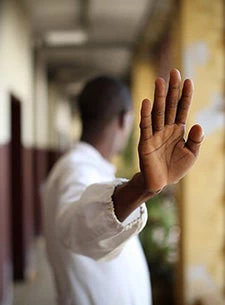
To end violence against women, we must ask the fundamental question of what is going on with men – the main perpetrators of this violence – and why societies worldwide are producing so many violent men?
As we know from the seminal 2013 WHO report, gender violence has reached epidemic proportions: fully one third of women worldwide – nearly one billion women – will experience physical violence from a male partner in their lifetimes. The problem has persisted or even increased in rich and poor countries alike – across age groups, classes, cultures and races.
The time has come to shift our thinking and approach to the perpetrators of this violence. We need to turn our attention to the behavior and motivations of the men and ask a different set of questions. What is going on with the men who are committing these violent acts? Why do so many men use violence against women and girls – particularly their own family members? Why is men’s use of violence against women so commonplace across countries in the world today? And how do institutions perpetuate the practice of men abusing and violating women?
Violence against women is closely linked to the rigid norms that define what it is to be a man. Worldwide there is a dominant model of manhood and men are taught to aspire to and judge themselves based on this ideal. Men are expected to be financially independent, become husbands and fathers, be the primary income earner for the family, be achievers in the eyes of peers, and be in control and exert authority. These salient norms of manhood are perpetuated by societies, communities, peers, families and women themselves – and take on more extreme forms in some cultures.
But for most men, particularly poor men, there is a huge gap between these expectations and what they can achieve. In the face of chronic poverty, inequality, exclusion, jobless economies, many men feel they don’t measure up.
In a household survey of 1,552 men in India, for example, one third of men said they were ashamed to face their family because they were jobless or did not earn enough income. Those unemployed men who reported being stressed or ashamed were 50 percent more likely to use violence against a partner and twice as likely to have used sexual violence than men who did not report economic stress.
So what do we do?
Ultimately, societies must challenge the impossible-to-achieve demands of manhood and the patriarchal structures that underpin these demands. We need to redefine notions of manhood and find alternative masculine identities that are not destructive to women and men alike. This is a long-term prospect but it starts by changing the way we – both women and men – raise boys to be men.
In practical terms, involving men in programs on sexual and reproductive health, maternal and child health, fatherhood and HIV/AIDS programs, has shown to bring positive changes in men‘s attitudes and behaviors. And the good news is that this programming for men is becoming more frequent and showing results.
We also urgently need to better understand male motivations for violence. While data are limited, the IMAGES and Partners for Prevention surveys, offer the most comprehensive analyses to date on men’s attitudes and practices on gender violence. We need to expand these surveys to more countries and use the data to tailor prevention strategies.
As we reflect during these 16 Days of Activism we need to work differently and more creatively to end this egregious and pervasive form of violence against women. This means addressing men’s gender issues to prevent violence before it happens, and making men a central part of the solution.



Join the Conversation